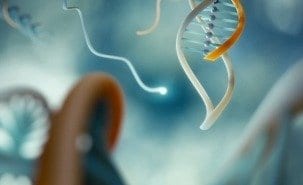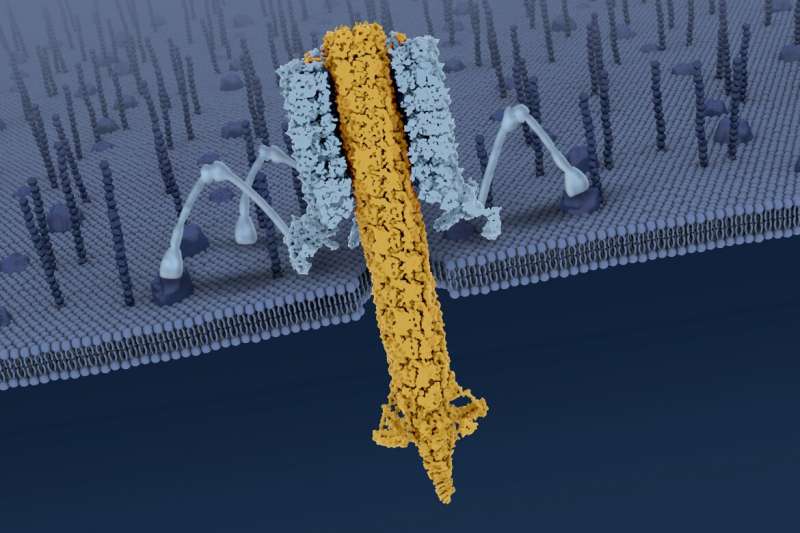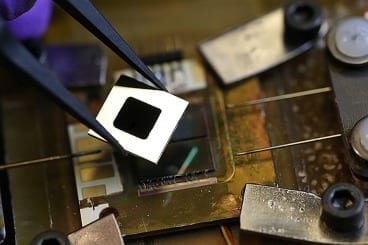
Toward a new generation of screening tests
As part of an international research project, a team of researchers has developed a DNA clamp that can detect mutations at the DNA level with greater efficiency than methods currently in use. Their work could facilitate rapid screening of those diseases that have a genetic basis, such as cancer, and provide new tools for more advanced nanotechnology.
An increasing number of genetic mutations have been identified as risk factors for the development of cancer and many other diseases. Several research groups have attempted to develop rapid and inexpensive screening methods for detecting these mutations. “The results of our study have considerable implications in the area of diagnostics and therapeutics,” says Professor Francesco Ricci, “because the DNA clamp can be adapted to provide a fluorescent signal in the presence of DNA sequences having mutations with high risk for certain types cancer. The advantage of our fluorescence clamp, compared to other detection methods, is that it allows distinguishing between mutant and non-mutant DNA with much greater efficiency. This information is critical because it tells patients which cancer(s) they are at risk for or have.”
“Nature is a constant source of inspiration in the development of technologies,” says Professor Alexis Vallée-Bélisle. “For example, in addition to revolutionizing our understanding of how life works, the discovery of the DNA double helix by Watson, Crick and Franklin in 1953 also inspired the development of many diagnostic tests that use the strong affinity between two complementary DNA strands to detect mutations.”
“However, it is also known that DNA can adopt many other architectures, including triple helices, which are obtained in DNA sequences rich in purine (A, G) and pyrimidine (T, C) bases,” says the researcher Andrea Idili, first author of the study. “Inspired by these natural triple helices, we developed a DNA-based clamp to form a triple helix whose specificity is ten times greater than a double helix allows.”
“Beyond the obvious applications in the diagnosis of genetic diseases, I believe this work will pave the way for new applications related in the area of DNA-based nanostructures and nanomachines,” notes Professor Kevin Plaxco, University of California, Santa Barbara. “Such nanomachines could ultimately have a major impact on many aspects of healthcare in the future.”
“The next step is to test the clamp on human samples, and if it is successful, it will begin the process of commercialization,” concludes Professor Vallée-Bélisle.
The Latest on: Nanomachines
[google_news title=”” keyword=”Nanomachines” num_posts=”10″ blurb_length=”0″ show_thumb=”left”]
via Google News
The Latest on: Nanomachines
- Three Miami University students selected as 2024 Goldwater Scholarson April 23, 2024 at 5:00 pm
Miami University juniors Audrey Allen, Chanakya Pandya, and Cece Meinking were named Goldwater Scholars for 2024-2025. They are among 438 students nationwide to receive the scholarship ...
- Nanomachines: Learning from Nature to Revolutionize Nanotechnologyon April 8, 2024 at 6:00 am
Nanomachines are nanoscale devices that can perform specific tasks at the molecular level. These tiny machines, typically ranging from 1 to 100 nanometers in size, are found in both biological systems ...
- The FOO Show: Episode 3 - Making Nanomachines from DNAon April 7, 2024 at 10:21 am
All the Latest Game Footage and Images from The FOO Show: Episode 3 - Making Nanomachines from DNA This week, Will explores the magical world of the microscopic and checks out some nanomachines in ...
- Molecular Motors: Nature's Nanomachineson April 1, 2024 at 12:09 am
Molecular motors are biological nanomachines that convert chemical energy into mechanical work at the molecular level. These highly efficient and specialized proteins are responsible for a wide range ...
- Synced preview - a pop-punk flavoured post-apocalypseon August 6, 2023 at 4:31 am
Hideous amalgams of nanomachines roam the post-apocalyptic world of first-person shooter Synced – but you won’t be facing them alone. The upcoming co-op FPS sees your character forming an ...
- 10 Awful Movie Death Retcons EVERYONE Hatedon April 21, 2023 at 5:00 pm
"Nanomachines, son." It's revealed that, moments after Harry was shot in the head, Ginger (Halle Berry) arrived on the scene and encased his head in protective "alpha gel," before his damaged ...
- Stealthy nanomachines bypass brain's defenceson January 8, 2019 at 10:02 pm
The blood-brain barrier is nature’s border police: preventing microbes and damaging substances from entering the central nervous system. But it also thwarts medicines that could treat tumours ...
- What makes nanomachines work?on January 1, 2019 at 4:57 am
which they argue amount to a set of 'design principles' for nanomachines (Proc. Natl Acad. Sci. USA 106, 6900–6903; 2009). A chain of simple hard spheres will, if warm enough, adopt a plethora ...
- Protein Nanomachineson January 25, 2017 at 3:50 am
Lucent, who earned his bachelor’s degree at Wilkes and his doctorate at Stanford, is part of a world-wide scientific project dedicated to the study of proteins and molecules, which he describes as ...
via Bing News










